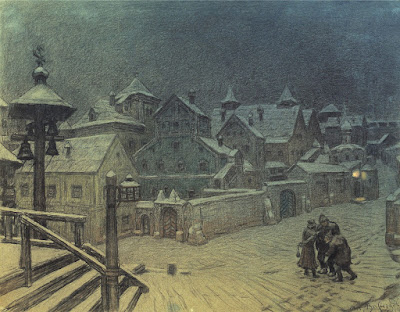I’ve made no secret of the fact that one reason I chose to set my historical novels during the childhood of Ivan the Terrible—who became the nominal ruler of Russia a few months after his third birthday and held the throne until his death at fifty-four—was because the history of that period is so dramatic that the stories almost tell themselves. When I began, I intended to start not long after Ivan’s accession to the throne and end with the suspiciously convenient death of his mother, Grand Princess Elena Glinskaya, four and a half years later. That is, indeed, the span of my first series, Legends of the Five Directions.
But when I found myself with a group of characters whose stories I’d planned to tell but had no room for—having had entirely unrealistic ideas of just how much I could cover in a single book—I was having too much fun to quit and decided to bring the series forward into the even more troubled and chaotic years that followed Elena’s death. That brought me, in due course, to the bride show held for the by then sixteen-year-old Ivan and, as of the current novel, the Great Moscow Fire that followed it. Or more accurately, as I discovered when I began to research the topic, not one fire but a series of three that wreaked havoc on Moscow from mid-April to late June, killing thousands and destroying the livelihood of many more.
This was sixteenth-century Europe, so governments thought nothing of catering to the wealthy and ignoring the woes of the poor. But in this case, so many people lost family members as well as all their belongings that the survivors lost patience with the callousness of those in charge and rioted in the streets. And because this was a time when people liked to blame their misery on sorcery, rumors circulated accusing the tsar’s grandmother, a Serbian princess (rightly or wrongly, Serbians were considered particularly likely to indulge in witchcraft), of turning herself into a bird and flying over Moscow, dripping liquid derived from a human heart to set the city ablaze.
An incredible story, to be sure, and from a historical standpoint highly questionable, not only because of its content but because of when the story appears in the official annals. If I were writing an academic article, I would exhibit extreme skepticism, mining the tale for evidence of who might have gained from spreading such nonsense decades after the last embers of the Great Fire fizzled into ash.
But I’m writing a novel, and the story is wonderfully indicative of how people dealt with trouble back then (and sometimes even today). The question for me is, as always, how to blend the lives and thoughts of my fictional characters into the broader historical arc created by the royal coronation and wedding, followed so closely by the near-destruction of Moscow.
Like most of us, my characters aren’t anticipating disaster; their problems, however important to them, seem quite small next to the larger drama playing out behind them. Yet they must interact with that bigger world, using outside events to solve their issues and get to where they need to go. How do they cope with tragedy? What strengths and weaknesses do they reveal? Do they resist the pressure of the maddened crowd or give in to the prejudices of their day?
I don’t know yet. But I’m about to find out. No doubt Yuri and Anna, like their predecessors, will surprise me. Just a few days ago, a cat showed up in the story and demanded, as cats will, a place at Anna’s side. I have yet to discover what role Mila the Cat will play, although I’m sure she will tell me when I need to know.
But as I write in almost every historical note, the most outrageous events in my novels are almost always historically attested. The old adage really is true: you can’t make this stuff up, because no one would believe you if you did.
As for the most outrageous coincidence in this particular novel, I think I’ll save that for a future post.
Because of changes to Wix, which hosts my main author website, and my own desire to consolidate my author persona in one secure location, I will be transferring my blog to my main site, https://www.cplesley.com, at the end of June 2023. The older posts—dating from June 2012!—will continue to be archived here for as long as I can make that happen.
Image: Apollinary Vasnetsov, Boyar Houses at Night (1918) looking distinctly smoky, public domain via Wikimedia Commons.

No comments:
Post a Comment
Ideas, suggestions, comments? Write me a note. (Spam comments containing links will be deleted.)